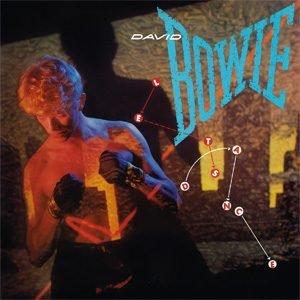Released in 1983, Let’s Dance stands as one of David Bowie’s most commercially triumphant and sonically transformative albums, marking a significant departure from his earlier work. For an artist as restless and adaptable as Bowie, this was less a reinvention than an exploration into yet another facet of his seemingly limitless musical persona. Moving away from the art rock and avant-garde leanings that defined his Berlin Trilogy (Low, “Heroes”, and Lodger) with Brian Eno, Let’s Dance is a bold foray into polished, dance-oriented pop-rock. Under the production of Nile Rodgers, co-founder of Chic and a master of infectious rhythms and sleek grooves, Bowie fully embraced the glossy, high-energy aesthetics that were reshaping mainstream music in the early 1980s.
Contextualizing the Album in Bowie’s Discography and the Music Landscape
By the early ’80s, Bowie had already built a career on shape-shifting between genres and personas, from the glam rock and gender-bending Ziggy Stardust era to the brooding, minimalist experimentation of his Berlin years. In many ways, Let’s Dance was a calculated pivot toward accessibility, embracing the synth-driven sounds and dancefloor allure of pop music at a time when artists like Michael Jackson and Madonna were dominating the charts.
Bowie’s desire to connect with a wider audience was evident: he wanted to transcend the avant-garde circles he had previously captivated and make an impact on popular culture at large. This drive resonated in Let’s Dance, an album that is as much a product of Bowie’s own creative ambitions as it is of the cultural zeitgeist.
Bowie’s Artistic Intentions with Let’s Dance
While Bowie’s 1970s work was steeped in introspection and intellectualism, Let’s Dance exudes a fresh confidence and a polished sense of spectacle. This pivot wasn’t just about adopting pop’s new gloss but reimagining how pop could reflect social and cultural layers. In various interviews, Bowie expressed his desire to produce an album that would resonate on dance floors and radio stations globally. Yet, in true Bowie fashion, Let’s Dance was more than a pop album; he intended it as a bridge between mass appeal and subversive artistry, merging irresistible hooks with themes of alienation, identity, and postmodern celebration.
With Rodgers bringing in his signature production style, the album gained a bright and funky edge while maintaining a sophisticated, cross-genre appeal. This sonic shift underscored Bowie’s ambition to unite art rock sensibilities with commercial appeal, creating a sound that was both accessible and impeccably crafted. In blending Rodgers’ expertise in funk and Bowie’s flair for storytelling and reinvention, Let’s Dance challenged and expanded the pop genre’s potential, laying the groundwork for a new era in Bowie’s already illustrious career.
Sonic Exploration

Let’s Dance represents a masterclass in polished, high-definition production, helmed by Nile Rodgers, whose knack for clean, groove-centered arrangements brings a crisp and vibrant sheen to every track. Bowie’s collaboration with Rodgers—a pioneer in disco and funk—ensured that the album sounded both precise and dynamic, a notable shift from the textured, ambient experimentation of Bowie’s late ‘70s work. Here, the production style is slick and radio-ready, capturing the precision and energy that defined early ‘80s pop while retaining enough nuance to appeal to Bowie’s more art-minded fans.
Rodgers’ meticulous approach to sound serves as the ideal foil to Bowie’s larger-than-life vocals, giving the album a punchy, danceable quality that is unmistakably modern for its time. This clear, bright production style doesn’t just enhance the infectious melodies; it aligns with Bowie’s desire to make a bold pop statement, underscoring themes of accessibility and cultural unity with universal appeal.
Musical Arrangements
The album’s arrangements are both sleek and purposeful, balancing catchy hooks with intricate, genre-blending instrumentation. Nile Rodgers’ guitar work, characterized by its sharp rhythm and clean funk lines, is a standout throughout the album, especially on tracks like “Let’s Dance” and “Modern Love.” His rhythmic, choppy guitar riffs infuse the songs with a groove that effortlessly pulls listeners onto the dance floor, while the rhythm section—featuring Tony Thompson’s precise drumming—creates a steady, infectious pulse. A unique aspect of the arrangements lies in how they blend pop and rock with traces of jazz and blues, particularly evident in the emotive trumpet lines in “Let’s Dance” that echo a retro swing style.
One of the album’s most memorable instrumental contributions is by Stevie Ray Vaughan, whose blues-infused guitar solos bring an edge and emotional depth to tracks like “China Girl” and “Cat People (Putting Out Fire).” Vaughan’s fiery guitar licks create moments of tension and release, adding depth to the otherwise pop-centric arrangements. Bowie’s own vocal arrangements are equally noteworthy—he effortlessly shifts from crooning to passionate outbursts, giving the songs a dynamic intensity. His vocal delivery is precise, embodying the emotional dualities of joy and alienation, often within the same track, which adds a richness to the album’s narrative arc.
Genre Elements
Stylistically, Let’s Dance fuses pop, rock, and funk with elements of jazz, blues, and even new wave, creating a vibrant tapestry that crosses genre boundaries with sophistication. While firmly rooted in pop’s accessible melodies and funk’s rhythmic drive, the album also introduces Bowie’s fans to a sound more associated with mainstream dance and radio hits. The title track, for instance, seamlessly combines a pop sensibility with disco-inspired beats, drawing on Rodgers’ deep understanding of rhythm and groove. The blend is far from formulaic; each genre element feels carefully woven to serve the song’s emotional tone, as in “China Girl,” which layers soft rock with hints of new wave synths, creating an exotic and cinematic feel.
Let’s Dance also manages to retain Bowie’s signature thematic complexity even as it ventures into commercial pop, partly because of its genre fluidity. “Cat People (Putting Out Fire)” has a darker, blues-rock intensity that contrasts with the brighter tracks, adding variety and depth to the album’s sonic landscape. Bowie’s ability to blend genres without losing his own voice as an artist is perhaps the album’s most striking innovation, as it challenged traditional genre boundaries in pop music.
By bringing together funk, pop, and rock with sophisticated production and arrangements, Let’s Dance not only captured the sound of its time but also set a new standard for genre-blending in mainstream music, establishing Bowie as a pop icon who was just as forward-thinking as he was accessible.
Lyrical Analysis

In Let’s Dance, Bowie’s lyrics weave a tapestry of themes centered on love, alienation, cultural identity, and the human experience, reflecting a mix of personal introspection and social commentary. While Bowie’s earlier albums often submerged these ideas within experimental narratives or abstract imagery, Let’s Dance presents them more directly, perhaps in keeping with its pop appeal. However, beneath the album’s accessible exterior lies a nuanced exploration of complex emotions and cultural tensions. Bowie’s lyrics speak both to personal connection and societal divides, making Let’s Dance a more layered work than it might first appear.
Themes and Messages
The album’s central theme is undoubtedly human connection and the desire to transcend social and personal barriers. The title track, “Let’s Dance,” with its seemingly simple invitation to join in a communal act of dancing, goes deeper upon closer inspection. Bowie describes dancing as a way to break through boundaries, with lyrics like “If you say run, I’ll run with you,” which capture a willingness to connect and escape constraints together.
In “Modern Love,” Bowie reflects on the conflict between individual desires and social expectations, presenting love as a concept fraught with anxieties and cultural conditioning. It’s a song about modern alienation, where faith, love, and existential searching are in constant friction with each other, capturing the essence of navigating life and relationships in a rapidly changing world.
“China Girl” dives into themes of fetishization and cultural misunderstanding, highlighting Bowie’s sensitivity to the dynamics of power and perception between the East and West. Co-written with Iggy Pop, this song is often seen as a critique of exoticism, exploring the complexities of desire and the objectification of “the other.” “Cat People (Putting Out Fire)” leans toward a darker reflection on primal instincts and suppressed rage, using fire as a powerful metaphor for inner conflict and repressed feelings. Across the album, Bowie’s lyrics alternate between personal musings and larger societal reflections, connecting individual experiences with broader human themes.
Lyrical Depth
While the lyrics on Let’s Dance are generally more direct than Bowie’s earlier work, they still carry a poetic depth that invites multiple interpretations. This lyrical shift suits the album’s pop aesthetic, as Bowie uses simpler language to convey universal ideas while retaining his knack for metaphor. In “Modern Love,” for instance, Bowie employs accessible language to speak on existential concerns, creating a dissonance between upbeat, almost jubilant melodies and lyrics that ponder the frustrations of modern life. This balance between simplicity and depth is a testament to Bowie’s ability to make complex ideas accessible without sacrificing his artistic vision.
“China Girl” stands out as a lyrical work of subtle provocation, using imagery and allusions to critique both Western romanticization of the East and the complex power dynamics within relationships. Bowie’s lyrics on the track are straightforward enough to resonate universally, yet the song’s meanings multiply when considering its cultural implications and the emotional layering in his delivery. Bowie’s lyrics on the album often use straightforward language to portray universal emotions and struggles, creating an approachable surface that hints at deeper, sometimes unsettling themes upon closer examination.
Emotional Impact
The lyrics of Let’s Dance amplify the album’s emotional impact by blending joyful release with reflective undertones. The infectious choruses and communal spirit of tracks like “Let’s Dance” evoke an almost euphoric joy, yet Bowie’s vocal tone—particularly in verses that carry darker or introspective messages—adds complexity to this joy, suggesting that it’s an escape or a fleeting relief from deeper concerns. On “Modern Love,” Bowie’s delivery is fervent yet conflicted, evoking the frustration and yearning of someone trying to reconcile personal desires with societal pressures. This emotional push-and-pull resonates, capturing the paradoxes of love and faith in a world that can often feel isolating.
“China Girl” brings a sense of yearning and melancholy, as Bowie’s vocals shift between affection and intensity, while “Cat People” is imbued with a fierce, smoldering passion that speaks to the suppressed emotions many listeners might recognize in themselves. The lyrics across Let’s Dance invite listeners to feel the full spectrum of Bowie’s message—from the celebratory to the contemplative, the album’s lyrics make it not just a collection of danceable tracks but a thoughtful, emotionally resonant experience. Through its exploration of universal human themes, Bowie’s lyricism on Let’s Dance invites listeners into a world of introspection, connection, and ultimately, a shared release on the dance floor.
Cohesion and Flow

Let’s Dance showcases a carefully curated track progression that reflects Bowie’s intent to create both a unified sonic experience and an exploration of diverse emotional landscapes. The album opens with its most iconic tracks, inviting listeners into a world of high energy and communal joy, then gradually shifts to more introspective and complex territory. This progression allows Let’s Dance to feel both celebratory and contemplative, establishing an arc that evolves from exuberance to introspection. Each track builds on the themes introduced in the previous one, maintaining a strong throughline that guides listeners on a journey through Bowie’s reflections on love, identity, and cultural tension.
Track Progression
The album’s opening track, “Modern Love,” sets the tone with infectious rhythms and Bowie’s signature dynamic vocal delivery, blending high-energy instrumentation with lyrics that ponder human connection and modern disillusionment. This immediately flows into the title track, “Let’s Dance,” which continues the album’s celebratory vibe while introducing motifs of companionship and shared escape. These opening songs serve as the album’s peak of joyous energy, setting up a high-impact beginning that captures listeners’ attention and establishes the album’s pop appeal.
From there, the album moves into “China Girl,” a track that marks a shift in tone toward something more haunting and introspective. This progression from the ebullience of “Let’s Dance” to the darker, more complex territory of “China Girl” creates an effective contrast, enriching the album’s emotional narrative. The second half of Let’s Dance takes a more reflective turn with songs like “Without You” and “Criminal World,” where the pace slows slightly, and Bowie’s lyrics delve into themes of longing and identity.
“Cat People (Putting Out Fire)” serves as an intense penultimate track, adding a climactic burst of fiery emotion before the album closes with “Shake It,” a somewhat lighter, groovy tune that brings the listener back to the surface, leaving them with a sense of resolution.
Thematic Consistency
Let’s Dance maintains a remarkable thematic and stylistic consistency throughout its runtime. Thematically, the album is unified by its exploration of connection and alienation within a rapidly modernizing world. Although the lyrical subjects range from romantic entanglements to social commentary, these themes of interpersonal connection, cultural tension, and identity are threaded throughout, giving the album a cohesive philosophical undercurrent. The shifts from the ebullient “Modern Love” and “Let’s Dance” to the darker, more reflective tracks like “China Girl” and “Cat People” serve as a natural extension of Bowie’s thematic concerns rather than jarring detours, creating a narrative arc that feels intentional and unified.
Sonically, the album’s stylistic coherence is maintained through Nile Rodgers’ production, which combines funk, rock, and pop elements into a consistent sound palette that balances bright, danceable rhythms with Bowie’s emotional gravity. Rodgers’ touch is especially crucial in ensuring that the album’s shifts in mood—from energetic and playful to dark and contemplative—are anchored by a consistent, cohesive sound. The clean production and tight rhythmic foundations create a framework that keeps the album focused, even as it ventures into varied emotional territory.
Standout Tracks and Moments
Let’s Dance is packed with unforgettable tracks and moments that showcase Bowie’s flair for both emotional resonance and musical innovation. With each song contributing a unique facet to the album’s sound and story, several tracks and moments stand out as especially impactful. These highlights not only capture the essence of Bowie’s artistic vision but also reveal the intricate layers within the album that have contributed to its lasting appeal.
Highlight Key Tracks
“Let’s Dance”
The title track is arguably the album’s crown jewel—a cultural anthem that remains one of Bowie’s most enduring hits. “Let’s Dance” brilliantly combines infectious grooves with a smooth pop sheen, thanks to Nile Rodgers’ unmistakable production. The song’s simplicity is deceptive; beneath the bright, radio-friendly exterior, Bowie offers an invitation to dance that feels like a call for unity, escape, and expression. The interplay between Rodgers’ rhythmic guitar and Stevie Ray Vaughan’s blues-infused solo gives the track a unique, genre-blending appeal, solidifying its place in Bowie’s catalog as both a dance anthem and an artful commentary on connection.
“China Girl”
“China Girl” stands out as one of the album’s more complex and haunting tracks, showcasing Bowie’s ability to infuse pop with deeper, culturally charged meanings. Co-written with Iggy Pop, the song’s lyrics delve into themes of exoticism and the power dynamics of romantic relationships. The eerie, slow-building instrumentation contrasts with the album’s brighter hits, adding a tension that reflects the unsettling nature of its subject matter. Bowie’s restrained vocal delivery, followed by explosive moments of intensity, brings an emotional depth to the track, making it a haunting exploration of desire and disillusionment.
“Modern Love”
Opening the album with upbeat, high-energy flair, “Modern Love” is a driving exploration of contemporary existentialism. The song’s frantic pace and pounding rhythm section capture the urgency of Bowie’s themes, with lyrics that ponder love, faith, and the search for meaning in a fast-paced world. “Modern Love” perfectly balances accessibility with introspective lyrics, making it a standout that resonates on both an intellectual and visceral level. The song’s relentless energy, punctuated by Bowie’s spirited vocals, is a testament to his ability to tackle complex emotions within the structure of a danceable pop song.
Memorable Moments
Stevie Ray Vaughan’s Guitar Solo in “Let’s Dance”
One of the album’s most unforgettable moments comes in the middle of “Let’s Dance,” when Stevie Ray Vaughan’s blazing guitar solo cuts through the polished production with raw, bluesy intensity. Vaughan’s solo adds an edge to the track, providing a stark contrast to the otherwise smooth, danceable feel and introducing an unexpected emotional depth. This solo is a perfect example of Bowie’s genius in blending mainstream pop with elements that surprise and challenge listeners, capturing the tension between joy and melancholy that underpins much of the album.
The Line “It’s not really work / It’s just the power to charm” in “Modern Love”
This lyric from “Modern Love” is a powerful reflection of the album’s exploration of social roles and personal identity. Bowie’s delivery here is both playful and weary, capturing the tension between conforming to societal expectations and pursuing genuine connection. This moment stands as a thematic focal point, encapsulating Bowie’s commentary on the absurdity of modern life and the emotional struggles hidden beneath outward charm and success.
The Transition from “Let’s Dance” to “China Girl”
The shift from the bright, anthemic feel of “Let’s Dance” to the haunting and introspective tones of “China Girl” marks one of the album’s most effective transitions. This shift captures Bowie’s willingness to juxtapose light and dark within his music, emphasizing the duality of joy and alienation that defines Let’s Dance. The transition signals a turn toward deeper, more contemplative territory, giving listeners a glimpse into the complexity beneath the album’s pop exterior.
The Final Chorus of “Cat People (Putting Out Fire)”
“Cat People (Putting Out Fire)” is already an intense track, but its final chorus, where Bowie’s vocals rise in fury and passion, is a stunning moment that encapsulates the emotional weight of the song. Here, Bowie’s voice grows raw and urgent, capturing the primal energy and suppressed anger that the song’s lyrics evoke. It’s a climactic moment that gives the album a powerful edge, reminding listeners of Bowie’s unparalleled ability to convey raw emotion with theatrical flair.
Artistic Contribution and Innovation

Let’s Dance holds a pivotal place within the 1980s music landscape, both as a groundbreaking pop album and as a daring statement from an artist who was already an icon. Released at a time when pop music was becoming increasingly visual and rhythm-focused, the album marks Bowie’s conscious embrace of commercial appeal, yet with his trademark ingenuity. It took Bowie from avant-garde stardom to mainstream megastardom, reaching a wider audience while preserving the sophistication and thematic depth that had defined his earlier work. With Let’s Dance, Bowie expanded the boundaries of pop music, blending genres with technical precision and incorporating layered themes that, while accessible, ran deeper than most mainstream hits of the time.
Place in Genre/Industry
Within the genre of pop and rock, Let’s Dance is emblematic of a new wave of genre hybridization that characterized much of the 1980s. While Bowie had dabbled in rock, glam, and electronic experimentation in the 1970s, Let’s Dance stands as his foray into a refined pop and funk fusion that was fresh for its time. Collaborating with Nile Rodgers, Bowie broke into new stylistic territory, embracing the emerging sounds of funk and disco-influenced rock in a way that felt both timeless and decidedly modern. This bold pivot helped redefine what was possible in pop music, as Bowie proved that an artist with a history in experimental music could appeal to mainstream tastes without sacrificing substance.
Bowie’s choice to work with Rodgers, who was renowned for his work with Chic, was itself an innovative move, bridging the gap between art rock and dance music in a way that elevated both genres. By aligning himself with a producer known for creating infectious, groove-based tracks, Bowie brought a level of musicality and sophistication to the pop scene that raised industry standards. The album’s success didn’t just elevate Bowie’s profile but also paved the way for other artists, showing that genre-blending and experimental themes could thrive in the pop sphere.
Innovation
Let’s Dance stands out for its innovative production and genre fusion. Rodgers’ production brought a sharpness and clarity that was unusual for Bowie, whose previous works leaned toward lo-fi, textured soundscapes. The album’s polished production values enabled each instrument and vocal layer to stand out, creating an experience that was both intimate and cinematic.
The emphasis on groove, clean guitar lines, and rhythmic precision gave Let’s Dance a fresh sound that stood apart from the heavy reverb and thick synth layers that characterized much of the early ‘80s pop and rock. This approach made the album sound lighter and more spacious, allowing Bowie’s voice and Vaughan’s guitar work to take center stage in a way that hadn’t been heard in his earlier albums.
Genre Blending
One of the album’s most innovative aspects is its genre-blending approach, with elements of funk, blues, and pop layered seamlessly. “China Girl” combines exotic undertones with rock and pop, while “Cat People (Putting Out Fire)” explores a darker, brooding mix of blues-rock and cinematic soundscapes. Vaughan’s presence on the album as a blues guitarist lent an unusual edge to the tracks, infusing mainstream pop with unexpected riffs that added emotional and musical depth. This integration of blues guitar into polished pop production was a pioneering move that added to the album’s uniqueness, bridging genre boundaries and setting new standards for pop’s range of musical expression.
Thematically, Let’s Dance was groundbreaking for its subtle yet pointed exploration of themes like alienation, identity, and social disparity, delivering a deeper resonance than much of the era’s pop music. In “China Girl,” for example, Bowie juxtaposes catchy pop melodies with commentary on cultural fetishization and Western perception, offering a critique that was unusual for mainstream music at the time. By wrapping these themes in infectious hooks and sleek production, Bowie was able to introduce weighty ideas to the pop mainstream without compromising accessibility.
Closing Thoughts

David Bowie’s Let’s Dance stands as a bold, transformative work in his discography, showcasing both his artistic flexibility and his vision for bridging pop accessibility with intellectual depth. The album’s strengths lie in its meticulous production, the infectious energy of its compositions, and its deft blending of genres—thanks in no small part to Nile Rodgers’ precise, groove-focused production and Stevie Ray Vaughan’s blues-infused guitar solos. Bowie’s exploration of themes like love, identity, and cultural tension gives the album a deeper resonance, making Let’s Dance more than just a collection of catchy pop songs; it’s a commentary on modern existence and the human need for connection in an increasingly fragmented world.
While the album marked a successful commercial pivot for Bowie, some might consider its mainstream pop sound a departure from the experimental textures that characterized his ‘70s work. For fans drawn to the Berlin Trilogy’s rawness or the glam rock audacity of Ziggy Stardust, Let’s Dance might initially feel like a compromise. Yet, beneath its polished surface, the album reflects Bowie’s continuous evolution as an artist, showcasing his ability to push boundaries within any genre he explores. In this sense, Let’s Dance serves as both a daring reinvention and a natural progression, reminding listeners that Bowie’s artistry lies as much in his adaptability as in his innovation.
Place In Career
Let’s Dance is not only a landmark in Bowie’s career but a defining album of the 1980s, capturing the era’s sound while pushing it into new territory. For listeners, it offers a compelling blend of joyous rhythm and thematic depth, making it as enjoyable on the dance floor as it is rewarding for deeper reflection. This balance between accessibility and artistic substance has allowed Let’s Dance to age gracefully, remaining relevant and influential decades after its release.
Official Rating
Let’s Dance earns a solid 9 out of 10, reflecting its success as both a pop album and a work of artistic innovation. Bowie’s venture into mainstream appeal didn’t sacrifice his intellectual edge; rather, it redefined pop’s potential. The album’s occasional polish may feel like a slight departure from his earlier experimental grit, but the refined production serves its purpose in expanding Bowie’s reach without diluting his message. As a whole, Let’s Dance is a masterful fusion of style, substance, and social commentary—a rare feat that has earned its place as one of Bowie’s most iconic and enduring works.
